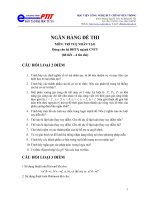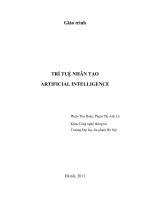Trí tuệ nhân tạo chapter8 game playing
Bạn đang xem bản rút gọn của tài liệu. Xem và tải ngay bản đầy đủ của tài liệu tại đây (118.96 KB, 28 trang )
Game Playing
Chapter 8
CuuDuongThanCong.com
/>
Outline
•
•
•
•
•
Overview
Minimax search
Adding alpha-beta cutoffs
Additional refinements
Iterative deepening
2
CuuDuongThanCong.com
/>
Overview
Old beliefs
Games provided a structured task in which it was very easy to
measure success or failure.
Games did not obviously require large amounts of knowledge,
thought to be solvable by straightforward search.
3
CuuDuongThanCong.com
/>
Overview
Chess
The average branching factor is around 35.
In an average game, each player might make 50 moves.
One would have to examine 35100 positions.
4
CuuDuongThanCong.com
/>
Overview
• Improve the generate procedure so that only good
moves are generated.
5
CuuDuongThanCong.com
/>
Overview
• Improve the generate procedure so that only good
moves are generated.
plausible-moves vs. legal-moves
6
CuuDuongThanCong.com
/>
Overview
• Improve the test procedure so that the best moves
will be recognized and explored first.
7
CuuDuongThanCong.com
/>
Overview
• Improve the test procedure so that the best moves
will be recognized and explored first.
less moves to be evaluated
8
CuuDuongThanCong.com
/>
Overview
• It is not usually possible to search until a goal state is
found.
• It has to evaluate individual board positions by
estimating how likely they are to lead to a win.
Static evaluation function
• Credit assignment problem (Minsky, 1963).
9
CuuDuongThanCong.com
/>
Overview
• Good plausible-move generator.
• Good static evaluation function.
10
CuuDuongThanCong.com
/>
Minimax Search
• Depth-first and depth-limited search.
• At the player choice, maximize the static evaluation
of the next position.
• At the opponent choice, minimize the static
evaluation of the next position.
11
CuuDuongThanCong.com
/>
Minimax Search
A -2
B -6
E
9
F
-6
G
0
C -2
H
0
I
-2
D -4
J
-4
K
-3
Maximizing ply
Player
Minimizing ply
Opponent
Two-ply search
12
CuuDuongThanCong.com
/>
Minimax Search
Player(Position, Depth):
for each S ∈ SUCCESSORS(Position) do
RESULT = Opponent(S, Depth + 1)
NEW-VALUE = PLAYER-VALUE(RESULT)
if NEW-VALUE > MAX-SCORE, then
MAX-SCORE = NEW-VALUE
return
BEST-PATH = PATH(RESULT) + S
VALUE = MAX-SCORE
PATH = BEST-PATH
13
CuuDuongThanCong.com
/>
Minimax Search
Opponent(Position, Depth):
for each S ∈ SUCCESSORS(Position) do
RESULT = Player(S, Depth + 1)
NEW-VALUE = PLAYER-VALUE(RESULT)
if NEW-VALUE < MIN-SCORE, then
MIN-SCORE = NEW-VALUE
return
BEST-PATH = PATH(RESULT) + S
VALUE = MIN-SCORE
PATH = BEST-PATH
14
CuuDuongThanCong.com
/>
Minimax Search
Any-Player(Position, Depth):
for each S ∈ SUCCESSORS(Position) do
RESULT = Any-Player(S, Depth + 1)
NEW-VALUE = − VALUE(RESULT)
if NEW-VALUE > BEST-SCORE, then
BEST-SCORE = NEW-VALUE
return
BEST-PATH = PATH(RESULT) + S
VALUE = BEST-SCORE
PATH = BEST-PATH
15
CuuDuongThanCong.com
/>
Minimax Search
MINIMAX(Position, Depth, Player):
• MOVE-GEN(Position, Player).
• STATIC(Position, Player).
• DEEP-ENOUGH(Position, Depth)
16
CuuDuongThanCong.com
/>
Minimax Search
1. if DEEP-ENOUGH(Position, Depth), then return:
VALUE = STATIC(Position, Player)
PATH = nil
2. SUCCESSORS = MOVE-GEN(Position, Player)
3. if SUCCESSORS is empty, then do as in Step 1
17
CuuDuongThanCong.com
/>
Minimax Search
4. if SUCCESSORS is not empty:
RESULT-SUCC = MINIMAX(SUCC, Depth+1, Opp(Player))
NEW-VALUE = - VALUE(RESULT-SUCC)
if NEW-VALUE > BEST-SCORE, then:
BEST-SCORE = NEW-VALUE
BEST-PATH = PATH(RESULT-SUCC) + SUCC
5. Return:
VALUE = BEST-SCORE
PATH = BEST-PATH
18
CuuDuongThanCong.com
/>
Adding Alpha-Beta Cutoffs
• At the player choice, maximize the static evaluation of
the next position.
> α threshold
• At the opponent choice, minimize the static evaluation
of the next position.
< β threshold
19
CuuDuongThanCong.com
/>
Adding Alpha-Beta Cutoffs
A
B 3
D
4
E < 4?
I
5
β cutoff
J
C > 3?
F
3
G
2
α cutoff
H
Maximizing ply
Player
Minimizing ply
Opponent
Maximizing ply
Player
Minimizing ply
Opponent
20
CuuDuongThanCong.com
/>
Adding Alpha-Beta Cutoffs
A
C > α?
B α
D
β
E < β?
I
v≥β
β cutoff
J
F
G
H
v≤α
α cutoff
Maximizing ply
Player
Minimizing ply
Opponent
Maximizing ply
Player
Minimizing ply
Opponent
21
CuuDuongThanCong.com
/>
Player(Position, Depth, α, β):
for each S ∈ SUCCESSORS(Position) do
RESULT = Opponent(S, Depth + 1, α, β)
NEW-VALUE = PLAYER-VALUE(RESULT)
if NEW-VALUE > α, then
α = NEW-VALUE
BEST-PATH = PATH(RESULT) + S
if α ≥ β then return
VALUE = α
return
PATH = BEST-PATH
VALUE = α
PATH = BEST-PATH
22
CuuDuongThanCong.com
/>
Opponent(Position, Depth, α, β):
for each S ∈ SUCCESSORS(Position) do
RESULT = Player(S, Depth + 1, α, β)
NEW-VALUE = PLAYER-VALUE(RESULT)
if NEW-VALUE < β, then
β = NEW-VALUE
BEST-PATH = PATH(RESULT) + S
if β ≤ α then return
VALUE = β
return
PATH = BEST-PATH
VALUE = β
PATH = BEST-PATH
23
CuuDuongThanCong.com
/>
Any-Player(Position, Depth, α, β):
for each S ∈ SUCCESSORS(Position) do
RESULT = Any-Player(S, Depth + 1, −β, −α)
NEW-VALUE = − VALUE(RESULT)
if NEW-VALUE > α, then
α = NEW-VALUE
BEST-PATH = PATH(RESULT) + S
if α ≥ β then return
VALUE = α
return
PATH = BEST-PATH
VALUE = α
PATH = BEST-PATH
24
CuuDuongThanCong.com
/>
Additional Refinements
• Futility cutoffs
• Waiting for quiescence
• Secondary search
• Using book moves
• Not assuming opponent’s optimal move
25
CuuDuongThanCong.com
/>









